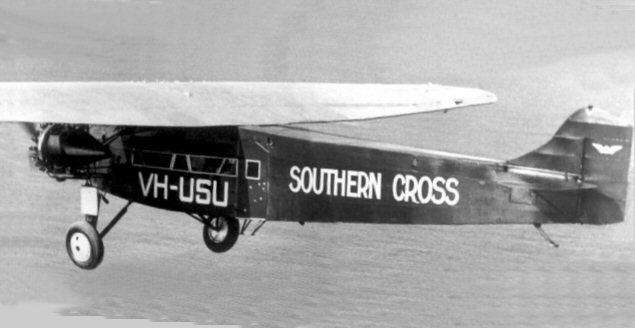VH-USU
Fokker F.VIIa/3m (c/n 4954)

Arguably the most famous
of Australian historic aircraft, this machine is now preserved in a
show-
case opposite the
International Terminal at Brisbane Airport. The aircraft itself
was donated to the
nation, but is in the care of the Brisbane Airport
Corporation. There is
also a replica of it, manu-
factured in 1987, based at Parafield Airport,
Adelaide, and now under the care of the Historical
Aircraft Restoration Society. This replica was
damaged when the landing gear collapsed during at
air show at
Parafield in 2002, and its status (end of 2004) is unknown.
However, for this web site I
wanted a photograph of the original, and am indebted to Ron Cuskelly
(founder of the site
http://www.adastron.com) for the above photograph which comes
courtesy of
the Queensland Air Museum. For more shots of this historic
aircraft (including some unidentified
venue ones) go to the next page.
Many articles and indeed books
have written about this aircraft and its flights, and hence I will give
the barest of historical details in this caption:
VH-USU was built in Amsterdam in
1927, bulk stripped and shipped to the USA where it was re-
assembled by the American Fokker
agents, the Atlantic Aircraft Corporation, in New Jersey.
It was purchased by George
Hubert Wilkins, who, with the backing of the Detroit News, decided to
undertake an Arctic (North Pole) expedition with
it. It was christened "The Detrioter" (for obvious
reasons) and was fitted with skis for this
endeavor. At that time it carried the US civil registration
N(C)1985. As was common in
those days, the NC was implied and never painted on the aircraft.
Many aircraft merely carried the "C".
"Southern Cross" had only the number (see the photograph
of it on the next page). In the event an
undercarriage failure led
Wilkins to abandon the Fokker as
his steed, and he carried out his historic
Polar flights in a Lockheed Vega.
The Fokker was shipped to
Seattle for repair by Boeing along with bits and pieces of Wilkins'
other
aircraft, a single-engine F.VIIa. There, the
aviator Charles Kingsford Smith (later Sir Charles)
and his colleague Charles Ulm purchased it for $3,000, and re-named it
"Southern Cross" In June of
1928, Kingsford Smith, along with
Ulm, Harry Lyon and James Warner departed San Francisco and,
after pit stops in Hawaii, and Fiji, landed at Brisbane on the 9th of
the month. Like Lindbergh before
them, the crew became famous overnight. From Brisbane the
aircraft flew on to Sydney, where the
heroes were welcomed by large
crowds. Other trans-Australia flights followed, the aircraft having
received the registration
allocation of VH-USU by this time. On Oct 10th and 11th Kingsford
Smith
became the first man to fly across
the Tasman Sea to New Zealand, again in "Southern Cross".
As a final feat, Smithy flew the aircraft to England and back to San
Francisco, thus becoming the first
man to circumnavigate the earth via Australia. (The Douglas World
Cruiser team flew around the world
in 1924, but did not venture as far south as Australia).
In 1935 Kingsford Smith donated
his historic aircraft to the Commonwealth of Australia, and, except for
a brief renewal of its C of A in
1945 for the purposes of making a film about Sir Charles' life, it has
remained in the museum in Brisbane ever since.
.
